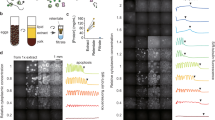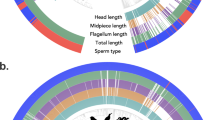Abstract
IN previous publications1,2 we have shown that a very constant relationship exists between the amount of deoxyribonucleic acid and the amount of arginine in the nucleus of an erythrocyte; we found the ratio 5.0 in the erythrocytes of all the species we studied (trout, pike, carp, tench, perch, barbel, roach). In the case of spermatozoa of some of these species, we found that this ratio is not the same as in erythrocytes. When the sperm contains a typical protamine (trout, pike), the ratio deoxyribonucleic acid/arginine is 1.6; in other cases (carp, tench) this ratio approximates to 5.0, just as in somatic nuclei.
This is a preview of subscription content, access via your institution
Access options
Subscribe to this journal
Receive 51 print issues and online access
$199.00 per year
only $3.90 per issue
Buy this article
- Purchase on Springer Link
- Instant access to full article PDF
Prices may be subject to local taxes which are calculated during checkout
Similar content being viewed by others
References
Vendrely, R., and Vendrely, C., Nature, 172, 30 (1953).
Vendrely, C., Knobloch, A., and Vendrely, R., Biochim. Biophys. Acta, 19, 472 (1956).
Daly, M. M., Mirsky, A. E., and Ris, H., J. Gen. Physiol., 34, 439 (1951).
Author information
Authors and Affiliations
Rights and permissions
About this article
Cite this article
KNOBLOCH, A., VENDRELY, R. An Estimation of the Nature of Nucleoproteins by an Analytical Method. Nature 178, 261–262 (1956). https://doi.org/10.1038/178261b0
Issue Date:
DOI: https://doi.org/10.1038/178261b0
This article is cited by
Comments
By submitting a comment you agree to abide by our Terms and Community Guidelines. If you find something abusive or that does not comply with our terms or guidelines please flag it as inappropriate.



